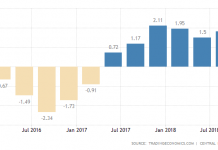The total financial flows from Nigeria’s oil and gas sector in 2016 was the lowest in a decade and the fifth lowest since the return of democracy in 1999, the latest Nigeria Extractive Industries Transparency Initiative (NEITI) Oil & Gas Industry Audit report has revealed. The report released on Friday in Abuja said aggregate earnings from the sector during the year dropped significantly by over 31 per cent from over $24.79 billion in 2015 to about $17.05 billion. Compared to the peak earnings of $68.44 billion recorded in 2011, the NEITI report, which covers 1999 to 2016, showed the 2016 figures plunged by over 75 per cent. “The plunge in revenue in 2016 resulted from the double whammy of low oil prices in the global market,” the NEITI Executive Secretary, Waziri Adio, is quoted to have said in a statement sent to PREMIUM TIMES by the transparency agency spokesperson, Ogbonnaya Orji. Mr Adio said the reduction in Nigeria’s oil production, in turn, was caused by the disruption and vandalism of oil assets and a spike in crude oil theft in the Niger Delta region, among others. Other key findings from the report were that the oil and gas sector contribution to the country’s gross domestic product (GDP) dropped from 9.5 per cent in 2015 to 8.3 per cent in 2016; total gas produced in 2016 was 3.05 trillion standard cubic feet (SCF), out of which 288.21 billion SCF, or 9.45 per cent, was flared. Also, about 126 million barrels of oil valued at $5.48 billion, or about N1.37 trillion was allocated for domestic consumption during the year. From the allocation, about 23 million barrels (18 per cent) was allocated for local refineries; 55.9 million barrels (45 per cent) for Direct Sale-Direct Purchase (DSDP) scheme; 36.6 million barrels (29 per cent) for the Pipelines and Products Marketing Company (PPMC) lifting, and 10.4 million barrels (8 per cent) for offshore processing arrangement. From the money for domestic crude allocation (DCA), the NNPC deducted about N512 billion upfront for Joint Venture (JV) cash call, N126.5 billion for pipeline repairs and maintenance, N99 billion for under-recovery from petroleum products imports and N20 billion for crude losses. Also, a total of 101 million barrels of crude oil valued at $4.4 billion was recorded as losses due to theft and sabotage, with SEPLAT Petroleum and Shell Petroleum Development Company (SPDC) alone accounting for over 81 million barrels of crude oil as losses due to sabotage. About 20 other entities reported 19.8 million barrels as losses due to theft. The Nigeria LNG dividend, loan and interest repayment for 2016, the report said, stood at about $390.2 million, as against $1.07 billion of 2015, a decline of 63.5 per cent. Again, out of about $8.2 billion budgeted for cash calls in 2016, about $5.5 billion was released, while about $4.9 billion was paid. Non-JV cash call expenses during the year came to about $874 million, representing 17.59 per cent of cash call expenditure. “Yearly, the average price of crude oil per barrel was $43.73 in 2016 as against $52.5 in 2015,” he said. “Total oil production in 2016 was 659 million barrels as against 776 million barrels produced in 2015, a fall of 15 percent. “Losses due to crude oil theft and sabotage rose from 27million barrels in 2015 to 101million barrels in 2016, an increase of 274 percent. This was aside from losses due to production deferments by the oil companies put at 144 million barrels in 2016. The figure went up to 65 percent when compared to the 87.5 million barrels in 2015.” The report identified the bombing of the under-water 48-inch Forcados Oil Loading/Export Pipeline in February 2016 as one of many major incidences the industry had to contend with during the year under review. Following the incident, operations on the pipeline were disrupted for over seven months, with Shell Petroleum Development Company (SPDC) declaring force majeure on crude oil lifting from the facility. Also, the report said other companies injecting into the Forcados Terminal, including SEPLAT, Panocean Oil, Midwestern Petroleum, Energia, Platform Oil & Gas, Pillar Energy, Waltersmith, and Excel were compelled to shut down production for over 147 days. Besides, the SPDC also declared force majeure on the Bonny Terminal due to a leak in Nembe Creek Pipeline between May and July 2016, while the Nigeria Agip Oil Company (NAOC) equally declared force majeure on the Brass Terminal between July and August 2016. According to the report, after surviving the slump in the global oil market in 2008 and 2009, Nigeria’s oil sector rebounded in 2010 with a 49 per cent increase in total financial flows to $44.94 billion, and a peak earning of $68.44 billion in 2011, with oil prices at the highest ever level above $140 per barrel. Since then, financial flows from the sector have been trending downwards, with $62.94 billion in 2012; $58.08 billion in 2013; $54.56 billion in 2014, and $24.79 billion in 2015. Similarly, oil production has been on steady decline, with about 866 million barrels produced in 2012; 800 million barrels in 2013; 798 million barrels in 2014; 776 million barrels in 2015 and 659 million barrels in 2016. The NEITI audit reports also independently reconcile payments by companies against receipts by government agencies, and cover key financial flows, such as earnings from the sale of the Federation’s equity crude oil and gas. The report also covers sector-specific taxes, fees and levies, including royalty, Petroleum Profit Tax (PPT), signature bonus, gas flared penalty, and other flows such as Niger Delta Development Commission (NDDC) contribution, Nigerian Content Development & Monitoring Board (NCDMB) levy, Nigerian Export Supervision Scheme (NESS) Fees, education tax and others. Details of the payment show the major earnings for 2016 came from export and domestic sale of Federation equity crude oil and gas with $7.97 billion, PPT with $4.21 billion, and royalty with $1.57 billion. A major highlight of the 2016 report was that for the first time in Nigeria’s history, crude oil produced from Production Sharing Contracts (PSCs) overtook output from the Joint Ventures (JVs). In 2016, PSCs accounted for 324 million barrels, while the JVs accounted for 289.1 million barrels, as against the 320 million barrels for PSCs and 375.5 million barrels for JVs in 2015. PSCs are production sharing contract arrangement introduced in 1993, which became the leading production arrangement in 2016. The PSCs are mostly offshore, thus insulated from vandalism and sabotage, and are not constrained by adequacy/availability of equity funding by the Federation. This change in production structure pushes to the fore the need to renegotiate the terms of the PSCs as stipulated in the Deep Offshore and Inland Basin Production Sharing Contracts Act of 1993 so as to increase government’s take. The NEITI report also reveals that the total lifting for 2016 stood at about 668.1 million barrels, as against the 780.4 million barrels lifted in 2015, a drop of about 14.35 percent. Out of the total liftings for 2016, NNPC lifted about 244.6 million barrels (36.61 per cent) on behalf of the federation, while the companies lifted 423.5 million barrels (63.39 per cent).
© African Voice Journal. Web Design By StapleDigital




















